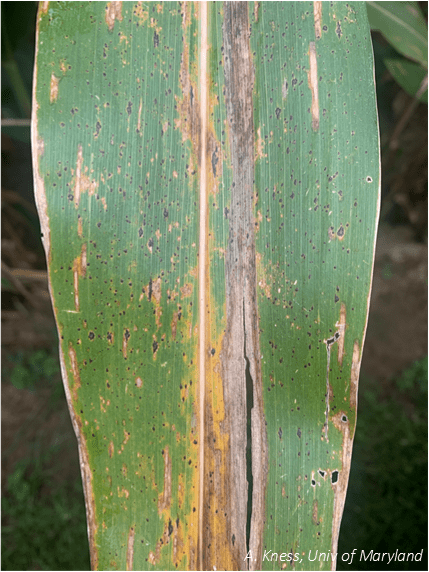Andrew Kness, Senior Agriculture Agent | akness@umd.edu
University of Maryland Extension, Harford County
During the month of September we have confirmed the presence of tar spot of corn in four additional counties in Maryland. Fields with tar spot in Queen Anne’s and Kent County were found on September 19, Baltimore County on September 22, and Caroline County on September 25, and Dorchester County on October 6. This brings the confirmed distribution from Carroll County east to Cecil and south on the shore to Dorchester County (Figure 1). In my scouting travels a few weeks ago on the eastern shore, I was able to find tar spot in two out of a dozen fields that I visited.

Note that this is the confirmed distribution—this is not to say that you will not find it outside of these reported counties; as a matter of fact, I’d be surprised if it’s not out there in several other areas across the state. As you harvest corn this fall, it might not be a bad idea to hop out of the cab and check around. Tar spot can still be visible on dry, senesced tissue. The signs of tar spot are dark black, raised spots that resemble spattered black paint (Figure 2). These spots are the reproductive structures of the fungus, Phyllachora maydis. These structures, called stromata, are embedded in the leaf tissue, are slightly raised (visible under a hand lens), and cannot be rubbed or scratched off the leaf.

When you are scouting you may notice several look-alikes that can fool you. Insect frass (poop) is one that looks very similar but you can wipe the spots off the leaf. You may also notice other fungi present on senesced tissue, giving the leaves a black appearance. These fungi are not tar spot but are instead secondary decomposers—i.e. they colonize dead plant tissue. You can distinguish these fungi from tar spot by looking closely at the spots. Tar spot will be strikingly dark black against the dead tissue and slightly raised, whereas these secondary fungi are less distinct and not raised (Figure 3). Also, tar spot infections start on green tissue that is still alive, so check the few green leaves that are still present for signs.

As far as management considerations for this year and moving into 2024: tillage has varied success and generally has very little effect on tar spot. While tar spot does overwinter on old crop residue and tillage can help accelerate residue decomposition, research from the Midwest has shown highly inconsistent responses to tillage for managing tar spot. A couple of reasons for this is because tar spot can be wind-blown short distances; and with the concentration of corn fields present in many areas of the state, inoculum can blow into “clean” fields from nearby infected fields. Another reason that tillage doesn’t have a major effect is because most tillage equipment (besides a moldboard plow) leaves at least some residue on the soil surface. Those exposed crop residues can be enough to get an infection started the following year.
A more effective management tactic to consider is hybrid genetics. While there is no complete resistance to tar spot, there are hybrids that tolerate it much better than others. Using more resistant hybrids next year can help manage this disease, especially in fields where you suspect that tar spot could be an issue. In addition, you can use planting date and hybrid maturity to your advantage. The combination of early planting and a early-maturing hybrids can be used to “avoid” tar spot infections by having corn beyond its critical growth stages (VT-R2) before cooler weather sets in later in the season, which is favorable to tar spot infection.
If you find tar spot in your fields, please report it by emailing akness@umd.edu or submitting a report at https://corn.ipmpipe.org/reporting-form/.
